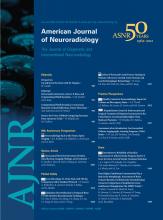We thank Dr. Zuccoli and Dr. Pipitone for their interest in our article.1 In our study, we evaluated the MR (1.5T or 3T) imaging findings of 23 patients with Wernicke encephalopathy (WE) at a university hospital: 13 nonalcoholic (NA) and 10 alcoholic (AL) patients. Although only 17% of the patients showed the classic symptom triad of WE, this percentage did not differ from that reported by other authors (16%–19%).2,3 Thus, MR imaging could be an important tool for early diagnosis and thus help reduce the associated morbidity and mortality, particularly when patients present with unclear clinical manifestations.4
We agree that the difference in the mean interval between symptom onset and MR imaging in the 2 studies may be responsible for some of the differences in brain MR imaging findings; in our study, the mean interval was 4.5 days,1 whereas in the study by Zuccoli et al, MR imaging was performed during the acute stage of WE.5 In our study, 14 patients underwent MR imaging within 3 days, 6 patients between 4 and 7 days, and 3 patients after 8 days following symptom onset. The involvement of typical and atypical sites, however, did not differ between the NA and AL groups at these time intervals. Little is known regarding the temporal progression in WE observed on MR images; in this regard, a large prospective study is warranted.
Although cranial nerve nuclei (CNN) are located in the dorsal medulla, we could not specifically differentiate each nucleus from the parts of the dorsal medulla that were involved; therefore, we simply reported signal alteration in the dorsal medulla. In our study, the involvement of the dorsal medulla and the periventricular gray matter of the fourth ventricle—the sites of many CNN—was observed in 14 NA patients and 10 AL patients, and Zuccoli et al5 reported that CNN involvement was observed in 32% of NA patients but in none of the AL patients. Thus, CNN involvement may by more common in NA patients, but our study did not show a statistical difference between NA and AL patients in this regard. Furthermore, in our study, the involvement of other atypical sites, such as cortical involvement, was observed in both groups. These results are concordant with those of some other studies.6,7
We agree with Zuccoli et al4,5 that atypical MR imaging findings usually occur in association with the typical MR imaging findings of WE and that prompt treatment with thiamine can avoid a dismal prognosis. Therefore, radiologists need to be aware of the spectrum of both typical and atypical findings. Although the MR imaging findings did not differ between AL and NA patients with WE in our study, MR imaging could still be a helpful tool for supporting the early diagnosis of WE in both the AL and NA groups.
References
- © 2012 by American Journal of Neuroradiology











